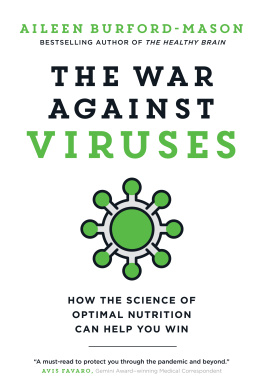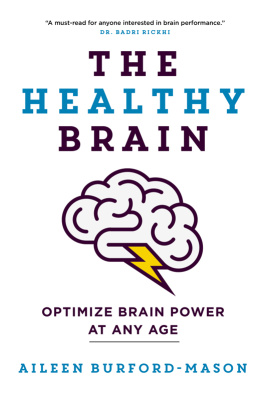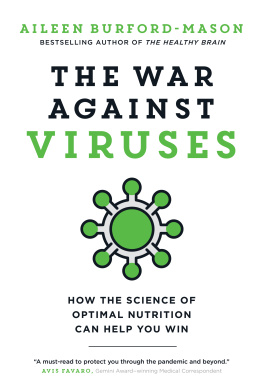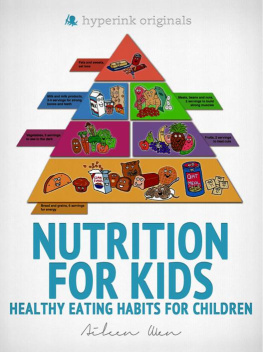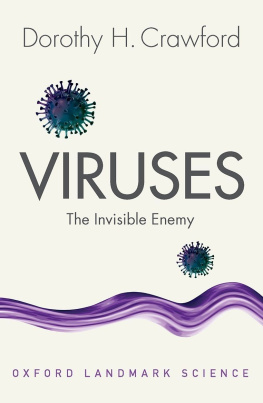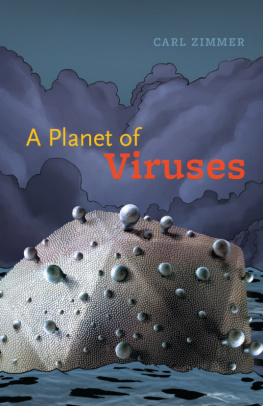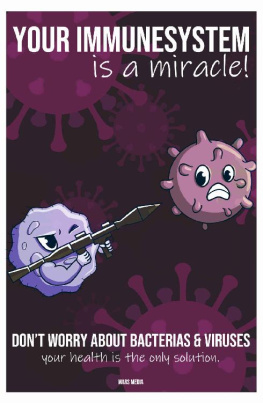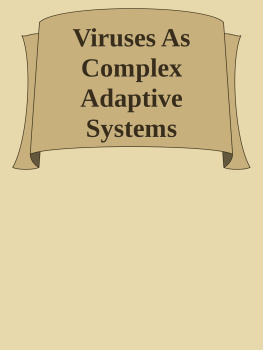For my friends Sampa Bhadra and John Martin
Contents
I n June 2019, I was in Vancouver to speak at a conference. My talk was on immunity and susceptibility to colds and flu, and it married two major interests of mine: the immune system and its workings, and nutrition. During the talk, I focused on the reliance of the immune system on a healthy diet. If the immune system malfunctioned, I suggested, maybe inadequate diets had something to do with it.
Towards the end of my talk, I raised the possibility that, sooner or later, we would be faced with an extremely contagious infection that could rampage across the world and cause many to fall seriously ill. Not an original idea. For some years, scientists had been sounding the alarm that a major pandemic, similar in magnitude to the Spanish flu of 191819, was likely, if not inevitable. In March 2020, the World Health Organization (WHO) classified a new fast-moving viral infection named COVID-19 as a pandemic.
As the pandemic unfolded, it became obvious that people were drowning in information, bombarded with new concepts and terminologies that were unfamiliar; that the lack of a basic knowledge framework with which to understand this crisis was adding to everyones anxieties. So many questions needed answering: What were the key components of the immune system, and how exactly did it work? What was so special about this new virus that it was a threat to global health?
For my part, I was concerned that there was so little discussion around nutrition and the vital role it played in supporting our immune systems, despite the fact that poor diets and chronically low intakes of nutrients like vitamin D had long been known to compromise our ability to fight infection. Missing from the public health debate was any notion that nutritional strategies might be helpful in the fight against COVID-19.
And so the concept for this book took shape. Although written against a backdrop of COVID-19, the book is not intended as a blow-by-blow account of the pandemics first year. At the time of writing, the pandemic shows no sign of abating, and a complete telling of its story may not be written for many years. Neither does this book aim to be a comprehensive primer on viruses or the immune systemthat would be an impossible task to accomplish coherently in one book. I simply want to give the reader enough information to understand why viruses pose a particular threat to health, and how, in battling them, our immune systems either work to our advantage or turn against us, causing us harm.
The nutritional strategies outlined in this book not only provide a recipe for improved health in general, but could go a long way towards improving immune health. Since scientists predict that this may not be the last pandemic we will be exposed to in our lifetimes, correcting nutritional inadequacies should provide enhanced immune support in advance of being exposed to any new and potentially lethal infections.
Aileen Burford-Mason
January 2021
The world is ill prepared to respond to an influenza pandemic or any similar global, sustained and threatening public health emergency. World Health Organization: Sixty-Fourth World Health Assembly, May 5, 2011
I ts New Years Eve 2019 and the party is in full swing. Ive spent the evening with a group of lively friends in Toronto, sharing food and drink and generally making merry. All evening, the wine has flowed freely and everyone is in high spirits. Some are dancing, others are sharing their New Years resolutions, which mostly appear to revolve around plans to improve health and fitness in the coming yearto lose those extra ten pounds that somehow crept up over the previous twelve months; to exercise more and give up alcoholat least for the month of January.
Around the world, this ancient celebrationringing out the old year and bringing in the newis steeped in significance. Its a time of reflection; a time for resetting goals and aspirations. Its a time to be upbeat and optimisticweve made it through the last 365 days relatively unscathed and are eager to see whats in store for us in the coming year.
Our hosts distribute flutes of champagne. Someone puts the TV on and we watch the festivities unfold in front of City Hall as the countdown begins. Exactly at midnight, the sky over Toronto fills with fireworks. Everyone exchanges hugs and kisses. Happy New Year, we wish each other. Hope its a great one!
But 2020 would not be the year we anticipatednot by a long shot. Rather than the health and happiness we were hoping for, we were about to enter a collective health crisis the likes of which the world had not experienced in a hundred years.
DECEMBER 31 IN CHINA
On the same day, on the other side of the world, the Chinese government was officially preparing to alert the World Health Organization to a worrisome outbreak of viral pneumonia occurring in Wuhana city of eleven million inhabitants and the largest transport hub in central China. The infection appeared to have started in a busy wet marketa food market where live animals were bought and then killed on site for food. Wet markets were known breeding grounds for infection, and the Chinese government had repeatedly but unsuccessfully tried to shut them down. The close proximity of the animalsoften wild or exotickept stacked in cages, together with poor hygiene at the market, allowed for easy transmission of disease from animal to animal. From time to time those infections jumped from animals to humans.
The outbreak quickly escalated, and within a few weeks 262 cities in China had reported cases. On January 23, two days before the Chinese New Year, the government declared the outbreak a national emergency. Concerned that the massive exodus of citizens from Wuhan during the New Year would further spread the infection, all transport in and out of the city was stopped. Suspected and confirmed cases were isolated, bus and subway travel suspended, schools and entertainment venues closed and public gatherings banned.
It would later transpire that the Chinese government had been reluctant to alert the world to the real scale and contagious nature of this new infection, and that they had silenced scientists who earlier had tried to raise the alarm. The most important factthat the virus was not only acquired by contact with infected animals, but was easily spread from person to personwould only gradually emerge. Governments everywhere were therefore slow in implementing travel bans to and from China, until it was too late. The horse was out of the starting gate and widespread dissemination of the virus, first to Europe and then progressively around the world, had already happened.
On January 13, the WHO declared the outbreak a public health emergency of international concern. As winter drifted into spring, the full magnitude of the outbreak became obvious. By early March, the outbreak was so widespread that the WHO declared that it now met all the criteria for a pandemic. Over the next weeks, country after country went into lockdown. Efforts to stop community spread included travel bans within and between countries, and mandatory quarantine of symptomatic individuals and anyone they had been in contact with.
Workplaces were shuttered, schools and places of worship were closed and people were instructed to stay at home, unless they needed to shop for food or medicine. No inviting your neighbour in for a cup of coffee and a chat; no hugging and kissing or handshakes. Social distancingmaintaining a two-metre or six-foot space between individualsbecame the new norm.
Despite early measures aimed at containment, the death rate rose relentlessly. In the worst-hit areas, makeshift hospitals sprouted in parking lots, open fields and city parks. Refrigerated trucks were pressed into use as temporary morgues to house the dead. As an article in the

